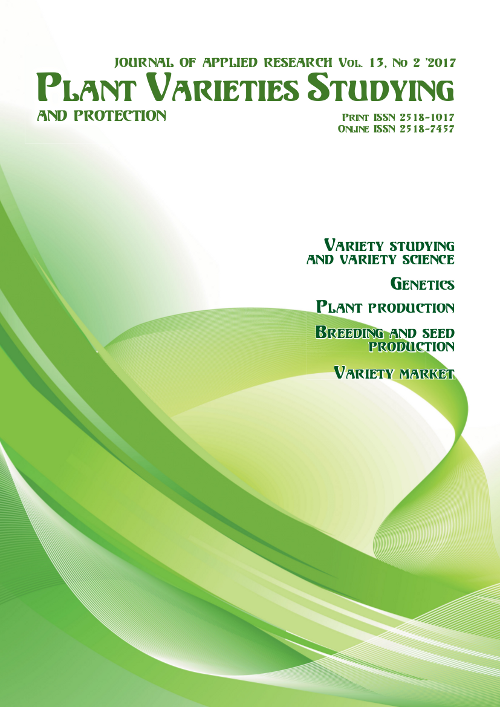On streamlining the Ukrainian names of plants. Information 9. Writing the names of plant varieties as objects of scientific and agricultural activities
DOI:
https://doi.org/10.21498/2518-1017.13.2.2017.105390Keywords:
cultivated plants, variety/cultivar, name/denomination, International Code of Nomenclature for Cultivated Plants, UPOV, CPVOAbstract
Purpose. To conduct the historical analysis of the practice of writing varieties names and other denominations of cultivated plants and development of relevant international rules and recommendations.
Results. The need to normalize the names of cultivated plants has matured in the horticultural environment more than a century and a half ago and was realized by the development of the International Code of Nomenclature for Cultivated Plants. During that period, the Code was expanded and improved, and now the IXth edition of the nomenclatural rules is valid. This nomenclature code has no legal status and is based on the voluntary consent of specialists to follow it for nomenclature stability, which is extremely important in international communication among scientists and businesspersons. International agreements for protection of plant breeder’s rights have been signed that is legally effective. Relevant rules have been developed governing the features of the creation, registration and operation of names of varieties and trademarks that relate to varieties as commercial objects.
Conclusions. The rules developed by horticulturists and botanists for naming cultivated plants have some differences with the rules for denomination of varieties as objects of intellectual property, which should be resolved for harmonization and increasing the effectiveness of scientific and economic activities. Knowledge of the nomenclature code and UPOV documents will assist the breeder in his professional activity.
Downloads
References
Candolle, A. de. (1867). Lois de la nomenclature botanique adoptées par le Congrès international de botanique, tenu à Paris en août 1867. Genéve et Bale: H. George ; Paris: J.-B. Baillièrе et fils.
On the rules of Botanical Nomenclature adopted by the Vienna congress. (1907). Rhodora, 9(99), 29–55.
Nicolson, D. H. (1991). A history of botanical nomenclature. Ann. Missouri Bot. Gard., 78, 33–56.
International Rules of Botanical Nomenclature. Cambridge Rules. (1935). Retrieved from http://www.iapt-taxon.org/historic/1935.htm
Symyrenko, V. L. (1995). Chastkove sortoznavstvo plodovykh kultur. T. 1: Yablunia [Particular variety investigation of fruit crops. Vol. 1. Apples]. Kyiv: Ahrarna nauka. [in Ukrainian]
Stearn, W. T. (1953). International Code of Nomenclature for Cultivated Plants formulated and adopted by the International Botanical Congress Committee for the Nomenclature of Cultivated Plants and the International Committee on Horticultural Nomenclature and Registration at the Thirteenth International Horticultural Congress (London, Sept. 1952). London: Roy. Hort. Soc.
Trehane, P. 50 Years of the International Code of Nomenclature for Cultivated Plants: Future Prospects for the Code. Acta Hortic., 634, 17–27.
Mizhnarodna konventsiia z okhorony novykh sortiv roslyn vid 2 hrudnia 1961 r., perehlianuta v m. Zheneva 10 lystopada 1972 r., 23 zhovtnia 1978 r. ta 19 bereznia 1991 r. [International Convention for the Protection of New Varieties of Plants]. (2006). Кyiv: Alefa. [in Ukrainian]
Jeffrey, C. (1977). Biological Nomenclature. (2nd ed.). London: Edward Arnold.
Pro okhoronu prav na sorty roslyn: Zakon Ukrainy vid 21 kvitnia 1993 r. No. 3116-XII [On the Protection of Plant Varieties. Law of Ukraine, 21 April 1993]. Retrieved from http://zakon2.rada.gov.ua/laws/show/3116-12 [in Ukrainian]
Mezhdunarodnyy kodeks nomenklatury kul’turnykh rasteniy [International Code of Nomenclature for Cultivated Plants]. (1974). Leningrad: Nauka. [in Russian]
Brickell, C. D., Alexander, C., David, J. C., Hetterscheid, W. L. A., Leslie, A. C., Malécot, V., & Cubey, J. J. (Eds.). (2009). International Code of Nomenclature for Cultivated Plants, 8th ed. Scripta Horticulturae, 10, 1–184 ; Regnum Vegetabile, 151, 1–184.
Brickell, C. D., Alexander, C., Cubey, J. J., David, J. C., Hoffman, M. H. A., Leslie, A. C., Malécot, V., & Jin, X. (Eds.). (2016). International Code of Nomenclature for Cultivated Plants, 9th ed. Scripta Horticulturae, 18, 1–190.
Explanatory Notes on Variety Denominations under the UPOV Convention [Document UPOV/INF/12/5 ; October 29, 2015]. Retrieved from http://www.upov.int/edocs/infdocs/en/upov_inf_12.pdf
Guidelines on Article 63 of Council Regulation (EC) 2100/94 of 27 July 1994 on Community plant variety rights. Retrieved from http://www.cpvo.europa.eu/documents/lex/guidelines/VD_ Guidelines_EN.pdf.
Variety denominations [Document UPOV/TC/49/8 ; February 21, 2013]. Retrieved from http://www.upov.int/edocs/mdocs/upov/en/tc_49/tc_49_8.pdf
Downloads
Published
How to Cite
Issue
Section
License
Copyright (c) 2017 Ukrainian Institute for Plant Variety Examination

This work is licensed under a Creative Commons Attribution-ShareAlike 4.0 International License.
Starting in 2022, the copyright to the publication remains with the authors
Our journal abides by the CREATIVE COMMONS copyright rights and permissions for open access journals.
Authors, who are published in this journal, agree to the following conditions:
- The authors reserve the right to authorship of the work and pass the first publication right of this work to the journal under the terms of a Creative Commons Attribution License, which allows others to freely distribute the published research with the obligatory reference to the authors of the original work and the first publication of the work in this journal.
- The authors have the right to conclude separate supplement agreements that relate to non-exclusive work distribution in the form in which it has been published by the journal (for example, to upload the work to the online storage of the journal or publish it as part of a monograph), provided that the reference to the first publication of the work in this journal is included.

























 Ukrainian Institute for Plant Varieties Examination
Ukrainian Institute for Plant Varieties Examination  Селекційно-генетичний інститут
Селекційно-генетичний інститут Institute of Plant Physiology and Genetics of the National Academy of Sciences of Ukraine
Institute of Plant Physiology and Genetics of the National Academy of Sciences of Ukraine
 The National Academy of Agrarian Sciences of Ukraine
The National Academy of Agrarian Sciences of Ukraine